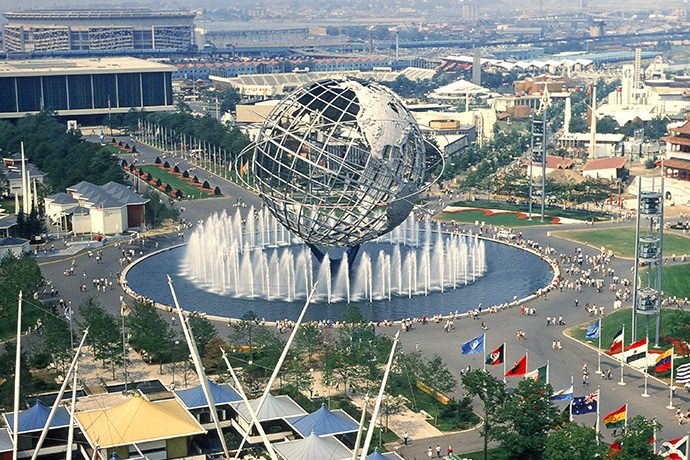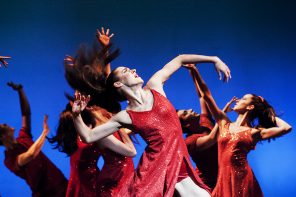More than 50 million people arrived in Queens in the summers of 1964 and ’65 to attend the World’s Fair at Flushing Meadows Corona Park, today the home of the USTA Billie Jean King National Tennis Center. Visitors to the park can revisit some of its greatest attractions and pavilions through a historical walking tour offered once a month by the New York City Department of Parks & Recreation.
Developed by New York City’s “master builder” Robert Moses, the 1964-65 World’s Fair was actually not a sanctioned world’s fair. Plans to host the fair over two separate years, as well as to charge rent to exhibitors, ran afoul of the rules set by the Bureau of International Expositions, the Paris-based organization that certifies world’s fairs.
So while world superpowers such as Britain, France and the Soviet Union boycotted New York’s fair, the show brought together exhibitors from smaller nations, U.S. states and major American corporations. Still, it didn’t lack for cultural firepower. Among its must-see attractions was Michelangelo’s “Pietà,” on loan from the Vatican, which visitors could view on one of three conveyor belts that moved at different speeds.
Walt Disney used the fair to test out his “Audio-Animatronics” robotics, which powered a lifelike Abraham Lincoln that premiered at the fair, as well as attractions such as the “Carousel of Progress” and “It’s a Small World,” which are still in operation at Disney World in Orlando, Florida.
The majority of the exhibitions and pavilions were torn down after the fair closed, but a volunteer-guided walk illustrates the details — large and small — left behind by the massive fair.
WAG recently took the tour, about an hour and a half total spanning the roughly 900-acre park. It included four people who attended the World’s Fair more than 50 years before, each of whom added some extra insight to the walk.
The tour started, naturally, at the park’s Unisphere. The 350-ton, 12-story globe is the largest representation of Earth in the world. Commissioned by U.S. Steel, the globe wasn’t just the centerpiece of the fair. Parks officials say it’s also at the geographic center of New York City’s five boroughs. (It would later be used in a 1990s ad campaign by the New York City Ballet, which featured principal dancers in key roles set against Big Apple landmarks. The Unisphere was paired with Bedford native Peter Boal, now artistic director of Pacific Northwest Ballet, dressed as the title character in George Balanchine’s “Apollo.”)
The Unisphere, guide Woo Sung Park explained, represented two of the fair’s major themes. “Peace Through Understanding” served as a counterpoint to a nation that was in the early days of the Vietnam War and was still coming to grips with the assassination of President John F. Kennedy a year earlier. But the globe also features three orbital rings that trace the routes of early satellites, emblematic of the fascination with space travel seen throughout the fair that would culminate with Apollo 11 landing on the moon.
America’s love affair with space can also be seen in one of a series of sculptures commissioned by the World’s Fair. In Donald De Lue’s “The Rocket Thrower,” a 43-foot bronze figure hurls a rocket-type object toward the sky with his right hand, while reaching for a constellation of stars with his left.
The tour also gives the backstory on Flushing Meadows park’s creation on a former ashheap that was the setting for the turning point in F. Scott Fitzgerald’s seminal novel, “The Great Gatsby.” The area was cleaned up and redesigned to host the 1939-40 New York World’s Fair, whose Modern, otherworldly pavilions beckoned tourists and locals alike. The profits from the popular fair were supposed to fund the creation of the park on the fairgrounds, but that fair actually turned a loss (as did the 1964 World’s Fair).
A significant representation of the 1939 World’s Fair is the Queen’s Museum. The structure was built to house the New York City Pavilion at the original fair, where it featured displays about municipal agencies. The building later served as the meeting place of the United Nations from 1946 to ’50. For the ’64 World’s Fair, the museum building was renovated again to host a massive panorama of every building in New York City, which the Queens Museum still exhibits today.
The tour also stops at the New York Pavilion and Terrace on the Park. The latter was designed as a helipad for the Port Authority of New York and New Jersey at the 1964 New York World’s Fair. The T-shaped structure (for “Transportation”) now operates as a popular catering hall.
The final stop on the tour was the 2,000-year-old “Whispering Column of Jerash.” The column is easy to miss within the park, but it’s actually the second-oldest antiquity in New York City, after the obelisk “Cleopatra’s Needle” in Central Park. The column was part of several erected in a temple in 120 A.D. in the Roman city of Jerash. The kingdom of Jordan presented the column as a gift to the 1964 World’s Fair. It’s a reminder that the park still holds princely experiences — and memories.
New York City Parks volunteers lead free tours on the second Sunday of each month through November. The 90-minute tours begin at 11 a.m. and at 1 p.m. at the Unisphere. For more, visit nycgovparks.org.




